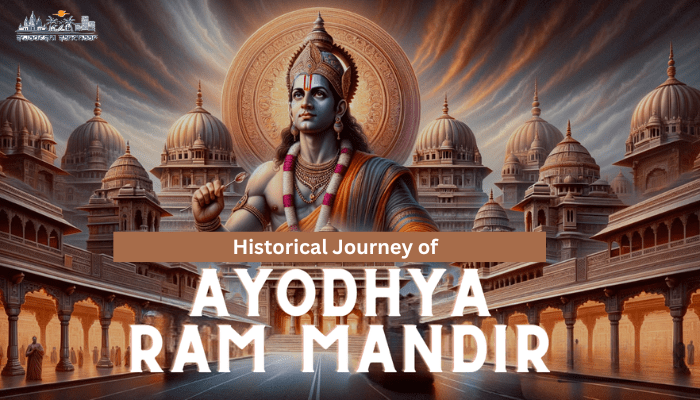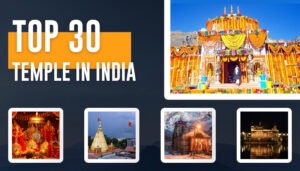The story of the Ram temple in Ayodhya is not just about the construction of a temple; This is a story woven with faith, politics, perseverance and centuries of devotion. From being at the center of one of India’s longest legal and religious disputes, to emerging as a symbol of cultural pride and spiritual unity, the journey of Ram temple is powerful and deeply emotional for millions.
In this article, we detect the historical timeline of the Ram Janmabhumi site, understand the controversy, and witness how a divine vision finally conquered through peaceful resolution and national will.
Mythological Significance: The Birthplace of Lord Ram
According to Hindu beliefs and ancient scriptures like Ramayana, Ayodhya is the birthplace of Lord Ram, which is the seventh incarnation of Lord Vishnu. It is believed that Lord Ram was born at an exact place in the Treta Yuga, where the Ram Janambhoomi temple is now being constructed.
For centuries, this site has been revered by devotees, pilgrims have visited Ayodhya to worship and perform rituals. The spiritual significance of this land remains intact through changing dynasties and historical ages.
Also Read : Trimbakeshwar Jyotirlinga Temple- A Spiritual Journey in Nashik
The Babri Masjid Construction (1528 AD)
In the year 1528, during the Mughal rule, Babur General Mir Baki was built on the site, a mosque, which was later known as Babri Masjid. Many Hindu devotees believed that an already existing temple marking the birthplace of Lord Ram was demolished to build a mosque.
It marked the beginning of a long -standing struggle between Hindu and Muslim communities over the ownership of land.
The Legal & Political Dispute Begins (1850s Onwards)
The first recorded religious conflict on the site took place in the 1850s, when the Hindu and Muslim clashed at the site. A fence was later created, separated by the internal court (used by Muslims) and the outer court (used by Hindus).
In 1949, idols of Lord Ram and Sita were mysteriously placed inside the mosque complex. This led to widespread tension, and the government declared the site disputed, closed the campus and banned further access to both communities.
Legal matters were filed by both sides, and the matter remained in the judicial part for decades.
The Demolition of Babri Masjid (1992)
On 6 December 1992, the Babri Masjid was demolished by a large crowd of tax servant during a political rally organized by Hindu nationalist groups. This incident led to large -scale communal riots and international resentment across India.
This incident became a significant turn in the history of the Ram Janmabhumi movement. While it intensified religious sentiments, it also deepened the urgency for legal resolution.
Supreme Court Verdict (2019): Faith Meets Justice
After years of hearing, submission of evidence, and after public debate, the Supreme Court of India gave its historic decision on 9 November 2019. A five-judge bench unanimously ruled that the entire 2.77 acres of disputed land was handed over to a trust for the construction of the Ram temple, which supports the existence of a pre-moisture structure.
The court directed the government to allocate 5 acres of land to the Sunni Waqf Board at an alternative site in Ayodhya to build a mosque.
The verdict was seen as fair, balanced and peaceful, ending a longer controversy for a decades and focused on faith and unity.
Construction of Ram Mandir Begins (2020)
Following the court’s decision, Shri Ram Janmabhoomi Tertha Kshatra Trust was formed to oversee the construction of the Ram temple. The Bhumi Pujan (Groundbreaking Celebration) was performed by Prime Minister Narendra Modi on 5 August 2020, marking a spiritual and political milestone.
The architecture of the temple is inspired by the ancient Nagra style, with complex carvings, 360 columns, and the place of the sanctum sanctorum for Ram Lalla as a child of Lord Ram. The project is being executed with crores of crores of crores worldwide.
Pran Pratishtha Ceremony (January 2024)
On 22 January 2024, Ram Lalla’s Grand Pran Pratasha Samaroh (Abhishek) was held in the sanctum sanctorum of the temple. The event was seen live broadcast by religious leaders, dignitaries and millions of devotees around the world.
The statue of Ram Lalla, carved by Arun Yogiraj, was installed in the sanctum sanctorum with full Vedic rituals. This moment was historical, emotional and spiritually powerful-a symbol of the culmination of a centuries-old dream.
Ram Mandir: A Symbol of National Unity and Cultural Identity
Today, the Ram temple not only stands as a religious place, but also as a symbol of national pride, cultural revival and peaceful resolution. It represents the strength of Indian democracy, where justice prevails through the constitutional route.
The temple is expected to become a global center of pilgrimage, which promotes the infrastructure, tourism and economy of Ayodhya. More importantly, it has closed a long and sensitive chapter in Indian history.
Also Read : Arunachaleshwara Temple Guide: History, Best Time & Festivals
Final Thoughts
Historical visit of Ram temple – from controversy to divine – is a will for the patience, belief and flexibility of Indian people. It is a reminder that when conflict can arise, they can be resolved with peace, respect and rule of law.
For devotees, historians and citizens equally, the Ram temple in Ayodhya is not just a structure; It is a sacred symbol of religion, justice and national unity.
Frequently Asked Questions
While tensions go back centuries, the modern legal battle began in 1949 when idols of Lord Ram were placed inside the mosque. The dispute escalated significantly in 1992 with the demolition of the Babri Masjid.
On 9th November 2019, the Supreme Court of India ruled in favor of the Hindu side, granting the disputed land for the construction of a Ram Temple and allocating a separate 5-acre plot for a mosque to the Sunni Waqf Board.
The groundbreaking ceremony (Bhoomi Pujan) for the Ram Mandir was held on 5th August 2020, with Prime Minister Narendra Modi laying the foundation stone.
The Ram Mandir is being constructed in the traditional Nagara style of temple architecture using pink sandstone, incorporating intricate carvings and grand pillars.
Yes, after the Pran Pratishtha ceremony in January 2024, the temple was opened to the public, and lakhs of devotees have since visited the holy site.




